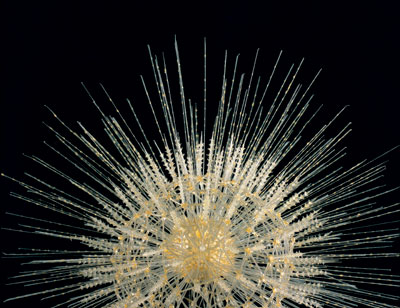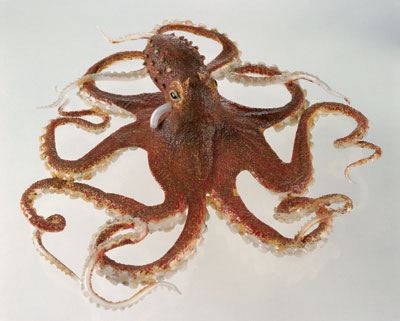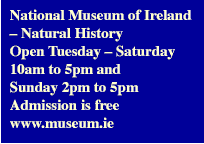| 2006 |

|
YEAR BOOK |
National Museum of Ireland � Natural History
|
Crystal Creatures at the Natural History Museum
|

One of the challenges in a museum is how to display microscopic animals or those with only soft tissues that look rather miserable when bottled in alcohol. In the 19th century the curators could choose from models made of a variety of materials including coloured wax. The finest models available however, were produced by a father and son team, Leopold and Rudolf Blaschka of Dresden.
The Natural History Museum opened in 1857 as the museum of the Royal Dublin Society. The museum was originally built as an extension to Leinster House, where the Royal Dublin Society was based for much of the nineteenth century. In 1877 ownership of the museum and its collections was transferred to the state. Full state funding allowed the curators to purchase animals needed to fill the gaps in the collections. A key weakness was among the invertebrates where the magic of the rock pool or microscope was hard to recreate in an exhibition. Anemones preserved in alcohol lose their colour and shrivel, jellyfish slump in a heap at the bottom of a jar.
Leopold Blaschka could trace his glass making ancestors back to 15th century Venice. Working in Dresden he manufactured jewellery and scientific apparatus. After the birth of his son Rudolf in 1857 he experimented with glass models of plants. This developed into a dominant part of his business and by 1877 when the museum in Dublin had funds for purchases he boasted a wide ranging catalogue of marine invertebrate models. The museum bought five lots of models over the next decade and amassed a collection of 530 items, now the largest single collection of Blaschka invertebrates in the world.
Staff in the museum have been researching the history of this collection, examining the materials and techniques used and planning the long term preservation of this national treasure. The first Blaschka Congress was held in Dublin in 2006 to bring together the international expertise in Blaschka models and share information and experiences of specialists and museum curators across Europe and North America. This is an important stage in a long term process of understanding a saving these collections in a number of museums. The project is managed through the CoBiD partnership between the museum and the School of Biology and Environmental Science, UCD.
The archives of the family business in Dresden survive in the Corning Museum of Glass in New York and are a valuable potential research resource. Conservator Lorna Barnes is responsible for the welfare of the Dublin collection and has been assisted with analysis of glass, metals and glues used in the models. Many of the models are a mixture of glass components and wires, glued together to give very lifelike representations of the animals. This mixture of materials poses challenges for long term preservation, particularly the glues that are now yellowed and embrittled with age.

The Blaschkas went on to produce glass models of flowers for Harvard University under an exclusive contract. That saw the end of their work on marine invertebrates. Their Harvard flowers are world famous, their marine animals much less well known but just as amazing. Since the 19th century few artists have attempted to copy the craftsmanship of the Blaschkas, those that tried becoming overwhelmed with the skill and patience required to follow in the footsteps of the greatest model makers ever to populate the displays of a natural history museum.

Contact: Nigel Monaghan, Keeper,
Natural History Division,
National Museum of Ireland,
Merrion Street, Dublin 2
Tel: +353-1-6777444 or Lo-Call 1890-MUSEUM (RoI only)
E-mail: [email protected]
Web: www.ucd.ie/blaschka